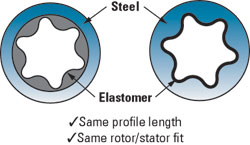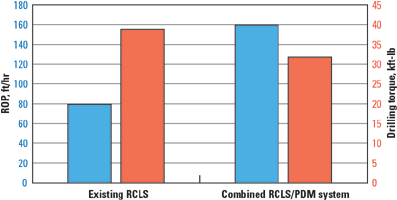Drilling Report
Integrating a high-speed rotary steerable system with a high-power drilling motor
Combining power with speed results in higher rate of penetration and full 3D deviation control to reach difficult areas of a reservoir. Another advantage is reduced casing and drill string wear.
Jon Ruszka, INTEQ, a division of Baker Hughes Incorporated
Since their introduction in the mid 1990s, the application and sophistication of rotary steerable systems has grown rapidly. Among the latest technology developments is the integration of a high-power drilling motor with a high-speed rotary steerable system. The higher speed enables integration of a high-power drilling motor within the system without compromising other drilling parameters. An example of where the higher rate of penetration (ROP) advantage has been verified is in the UK Central North Sea Cretaceous formations. Another advantage is extending the length of horizontal sections, such as in the Danish sector of the North Sea.
MORE POWERFUL DRILLING MOTORS
The latest generation of INTEQ’s AutoTrak Rotary Closed Loop System (RCLS) can operate at rotary speeds up to 400 RPM, compared to the typical industry standard maximum rotary speed specification of 200 to 250 RPM. High-power PDMs now available use the company’s proprietary technology “pre-contoured” motor power sections.
These power sections differ from a conventional PDM design, because the motor stator is pre-contoured in steel with a thin elastomer coating, as opposed to being moulded in solid elastomer contained within a steel tube, Fig. 1. These pre-contoured stator sections deliver more power output than conventionally constructed motors and are robust.
 |
Fig. 1. Compared to a Standard M1XL power section (left), which has a steel cylindrical tube lined with a varying rubber thickness, the new X-treme PDM motor has a pre-contoured stator in steel and a thin, “equidistant” rubber layer, which yields more power.
|
|
In parallel to development of the new high-speed AutoTrak systems, development commenced on a special PDM, using X-treme technology power sections, to integrate within the AutoTrak bottom hole assembly (BHA). This new system, called AutoTrak X-treme, allows the drill string to be rotated continuously at a sufficient rate to facilitate hole cleaning, but the requirement for drill string rotation from surface is decoupled from the desire for high ROP, Fig. 2. By combining the downhole power of advanced PDM technology with precise rotary steering control, a number of advantages are achieved.
 |
Fig. 2. Typical BHA with integrated high-speed rotary closed loop system with new PDM drilling motor.
|
|
HIGHER ROP
The most obvious advantage of combining a high-speed drilling system with a high-power motor is improvement in drilling performance. Certain formations are known to drill faster with power delivered directly to the bit from a downhole motor instead of from pure surface rotation. Where these formations are encountered, application of rotary steerable technology has been limited, because it is either un-economic, due to poor ROP, or unfeasible, due to the extended time the formation would be open prior to casing off. With this new system, delivering power directly to the drillbit and having the capability to rotate the bit at higher speed than is achievable with standard rotary steerable drilling, significant increases in ROP are achievable. In these circumstances, all the advantages of rotary steerable drilling can be attained while drilling at significantly higher ROP.
DRILLING IN THE NORTH SEA
An example of where the higher ROP advantage has been verified is in the UK Central North Sea Cretaceous formations. These hard formations can only be drilled at acceptable ROP using drilling motors. Another challenge with this formation is difficulty performing directional drilling work using steerable motors, due to the inability to reliably and efficiently slide drill, unless highly lubricious oil-based drilling fluids are used. Well trajectories through these formations are, therefore, often limited to either simple tangent sections or a slow drop, to minimize the requirement for directional work with steerable motors.
With many Central North Sea fields reaching maturity, there is an increased requirement for 3D directional work through the Cretaceous to reach remaining reserves. Previous experience of drilling with rotary steerable systems there has proven to be unacceptably slow. The new system has now been used on a number of challenging wells in this area with success. Using this system in 12-1/4-in. hole sections, full 3D deviation control has been achieved, allowing more difficult areas of the reservoir to be reached, while gross ROP has increased considerably compared to the best offset wells.
In addition to this efficiency gain, since the need for slide drilling is eliminated and openhole time reduced, operators have been able to convert from using oil-based drilling fluid to water-based systems. By enabling conversion to water-based drilling fluids, environmental exposure is dramatically reduced, while simultaneously providing further cost savings, both on the drilling fluid itself and minimizing the cost and operational risk of skip-and-ship cuttings disposal.
EXTENDING HORIZONTAL WELLS
The new system has also been operating to extend the reach of horizontal wells in the Danish sector of the North Sea. These fields comprise thin chalk reservoirs and are drained using highly extended lateral wells with 8-1/2-in. holes. Full and precise 3D directional control is required throughout the lateral drain to remain within the thin productive zones and provide the necessary drainage pattern. The objective of these wells is to provide a lateral drain that is as long as possible for maximum production.
RCLS systems have been used extensively with very good effect to drain these fields, which are always drilled with water-based drilling fluids. The reach of the wells has, however, typically been limited to about 25,000-ft MD, depending on precise well trajectory. This limit is set by the drilling rig’s capacity to deliver rotary power from the top drive to the drill bit. As the reach of the well increases, friction of the drill string within the casing and openhole consumes increasing amounts of energy. Further energy is lost by the onset of severe torsional vibration (stick-slip), until no further rotary drilling progress is possible. The new combined RCLS/PDM system is enabling lateral drains to be extended at least 5,000 ft further than previously possible, thereby increasing production, while considerably increasing ROP and maintaining the required, precise 3D-steering control, Fig. 3.
 |
Fig. 3. Picking up the new combined RCLS/PDM system at 23,000-ft MD on an extended reach horizontal well, ROP increased and drilling torque reduced, allowing significant extension to the lateral drain, past previous limits.
|
|
REDUCED CASING/ DRILL STRING WEAR
A challenge posed by operators making extensive use of rotary steerable systems is casing and drill string wear. Continuous, high drill-string rotary speeds required to efficiently drill with rotary steerable systems is, in some areas, causing concern about accelerated casing and drill string wear. While not yet quantified, it is anticipated that the new combined system will allow this potentially costly and hazardous risk to be reduced. By decoupling drill string rotary speed from drilling performance, full drill string rotation from surface is only necessary to facilitate hole cleaning and feed weight to the drill bit.
With this new system, it is therefore only necessary to rotate the drill string at a speed sufficient to agitate the cuttings for good hole cleaning. This rotary speed is often less than is frequently used to optimize ROP in normal rotary steerable applications. In addition to alleviating casing and drill pipe wear, the lower speed also reduces stress on the rig’s rotary system, resulting in reduced rig downtime. This aspect of the system will be particularly valuable in re-entry applications, where the mother well may be old and the existing casing is already worn from previous drilling operations and corroded over time.
DRILLING PAST 50,000 FT
Since trials began with the new combined RCLS/PDM system two years ago, the advantages of high-speed, high-power drilling in this manner extend beyond gross ROP improvement. With several studies underway worldwide to assess the viability of drilling wells past 50,000 ft (15 km) reach, this new drilling system could provide the technology to enable such feats. 
THE AUTHOR
|
| |
Jon Ruszka is the Advanced Drilling and Evaluation market analyst for Baker Hughes INTEQ in Aberdeen. He earned a BSc with Honors in aeronautical engineering from Bristol University and postgraduate diploma in offshore engineering from RGIT in Aberdeen. He began his career with Dresser Atlas in 1985 as a wireline engineer and joined Eastman Christensen in 1987 as a directional surveyor. He specializes in directional drilling.
|
| |
|
|





